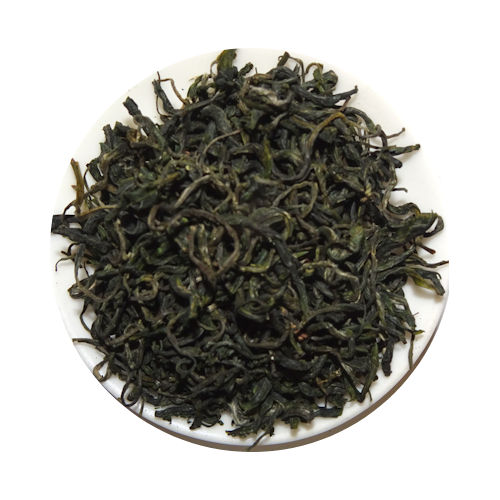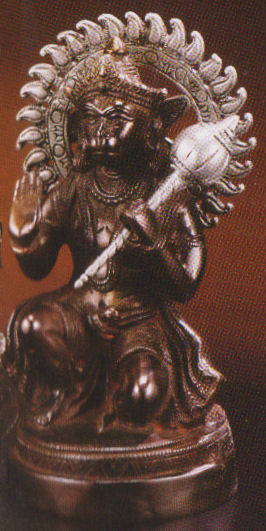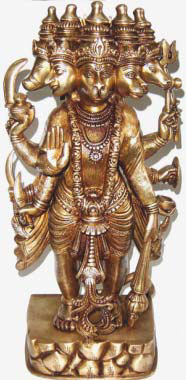Hanuman, also known as Hanumat and Pavan-Sut, is one of the most
popular deities amongst Hindus and is seen in temples throughout India.
His picture, often with Rama and Sita, can be found in almost every
Hindu home. He is considered to be the god of power and strength and as
such is the most favored deity of wrestlers and especially venerated by
princes and warriors; Tuesday is his sacred day of worship. In Nepal,
his images are usually covered with a thick vermillion mixed with
mustard oil and often dressed in a red cloth with a red or golden
umbrella over his head.
Hanuman is the son of Vayu, the lord of
winds, and Anjana, his consort. He is described in the Ramayan, the
Mahabharat and Agni Puran as having a short thick neck, a round
monkey-face as red as a ruby, yellow skin glowing like moltan gold,
sharp white fangs, a mane like flowers, a tail like a banner of
interminable length, and the ability to expand until he is as large as
a mountain or to contract until he is as small as a fly. He has a roar
like thunder, leaps into the air and flies among the clouds with a
rushing noise.
Hanuman remained celibate his entire life and is
known as the greatest devotee of the god Rama, who loved him the best.
His devotion to Rama and Sita was so great that once he tore open his
chest with his claws to show that images of Rama and his wife were
engraved upon his heart. He is famous for helping Rama destroy Ravana,
the ten-headed demon king, and for organizing the building of a bridge
from India to Ceylon (Sri Lanka).
There are many interesting
myths surrounding this god. When quite young, he saw the rising sun and
thought it to be a ripe fruit. He therefore jumped up to it and put the
sun in his mouth. The other gods and goddesses feared that the world
would perish without the sun and prevailed upon him to spit it out.
When Hanuman was only ten years old he could lift the hills twenty
miles in circumference and throw these about as if they were stones.
- Categories
-
Rare Teas: Gourmet Loose Tea
- Green Teas
- White Teas
- Yellow Teas
- Jasmine & Floral Teas
- Oolong Teas
- Black Teas
- Purple Teas
- Pu-erh Teas
- Organic Teas
- Display Teas
- Blended Teas
- Herbal Teas
- Decaffeinated Teas
- Teapots
- Tea Accessories
- Lacquerware
- Dinnerware
- Ikebana & Gardening Supplies
- Sake Sets
-
Inspired Gifts
- 2019 - Year of the Boar
- 2018 - Year of the Dog
- 2017 - Year of the Rooster
- 2016 - Year of the Monkey
- 2015 - Year of the Ram
- 2014 - Year of the Horse
- 2013 - Year of the Snake
- 2012 - Year of the Dragon
- Artist Hajime Okamoto
- Chinese Astrology
- Chojyu Giga
- Gift Sets
- Incense Gift Sets
- Kabuto - Samurai Helmet
- Magnet Sets
- Omamori (Amulets)
- Sushi Sets
- Tosa Handcrafted Iron
- Gods & Goddesses
- Table Top
- Japanese Textiles
- Soap, Body Powder & Sachet
- Gourmet Foods
- Gift Certificates
- Explore
-
Rare Teas: Gourmet Loose Tea
- Information
- Contact Us
- Explore







